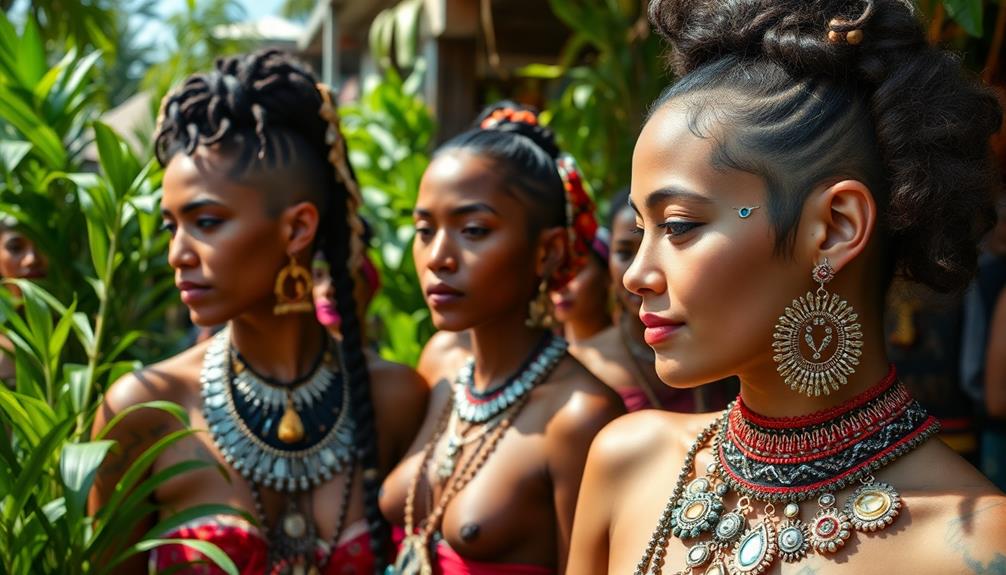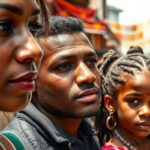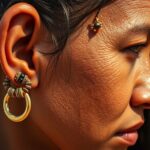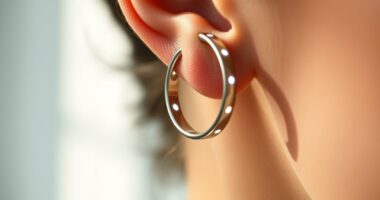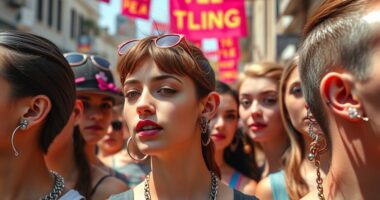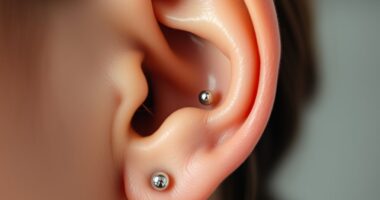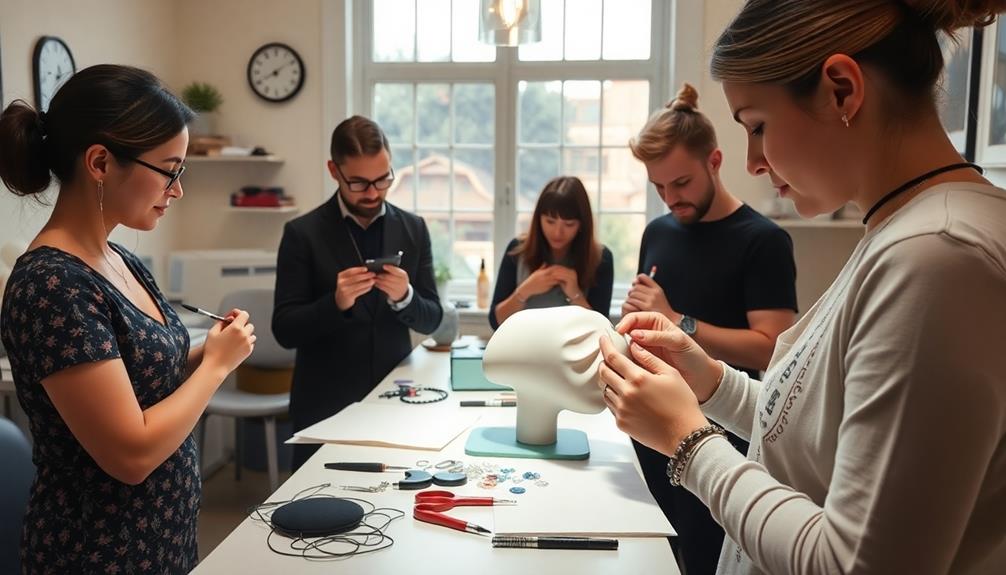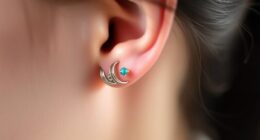If you're enthusiastic to explore piercing tourism, you'll find intriguing destinations that celebrate unique body modification practices. In Thailand, experience traditional ear stretching and spiritual Sak Yant tattoos. India boasts rich nose-piercing customs tied to Hindu marriage rituals, while New Zealand's Māori ta moko connects you to indigenous culture through intricate facial tattoos. Japan offers a blend of traditional and modern styles, particularly in Tokyo's studios. In the U.S., cities like Los Angeles and New York push the boundaries of avant-garde piercing techniques. There's so much more to discover about these enchanting practices waiting for you!
Key Takeaways
- Thailand offers traditional ear stretching and spiritual Sak Yant tattoos, connecting travelers to local culture and beliefs.
- India features significant nose-piercing traditions during Hindu marriage rituals, showcasing diverse styles with deep cultural meaning.
- New Zealand is known for Māori ta moko, which expresses tribal identity through facial tattoos and honors indigenous heritage.
- Japan combines traditional kanji with modern piercing techniques, particularly in Tokyo, enhancing cultural artistry in body modifications.
- United States cities like Los Angeles and New York showcase innovative piercing methods and avant-garde styles, reflecting contemporary trends in body modifications.
Cultural Significance of Body Modifications
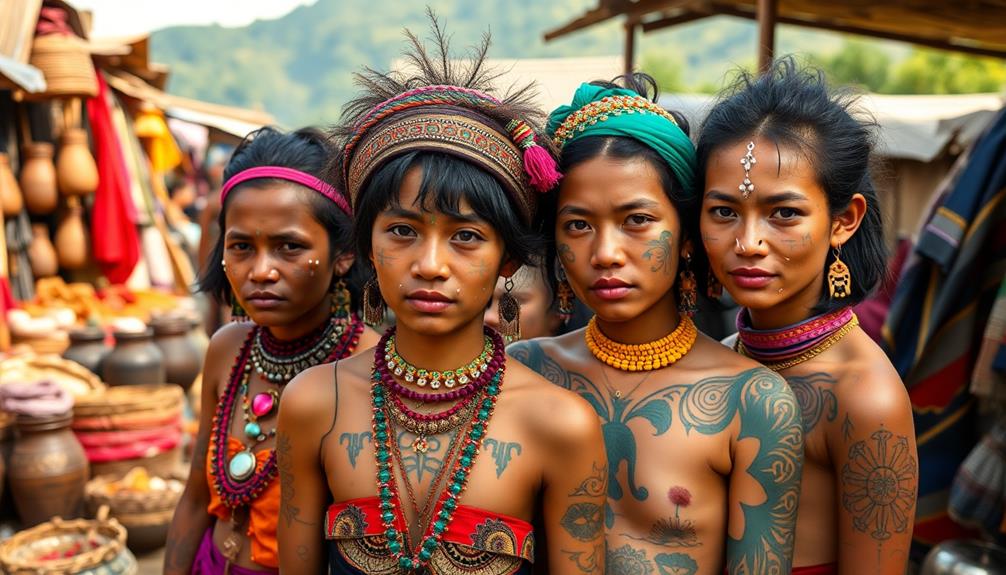
Body modifications, like tattoos and piercings, carry profound cultural significance that varies across different societies. When you explore body piercing or other forms of body modifications, you'll find that these practices often reflect deep spiritual beliefs, social status, or important life events.
For instance, in ancient Maya culture, tattoos and tooth inlays represented strength and spirituality. The pain endured during these modifications was believed to elevate one's status within the community.
Similarly, in many African tribal cultures, scarification serves as a rite of passage, marking significant life events and establishing individual identity.
You might also notice that body piercing has historical roots worldwide. Nose piercings have been prevalent in the Middle East since around 4,000 B.C., showcasing the cultural norms of that time.
Meanwhile, Polynesian tattoos, known as moko, symbolize lineage and pivotal life events, weaving cultural identity into the very fabric of their society.
Understanding the cultural significance behind these body modifications allows you to appreciate the rich history and meaning that accompany each choice. Each mark or adornment tells a story, connecting you to traditions that span generations.
Top Destinations for Piercing Tourism
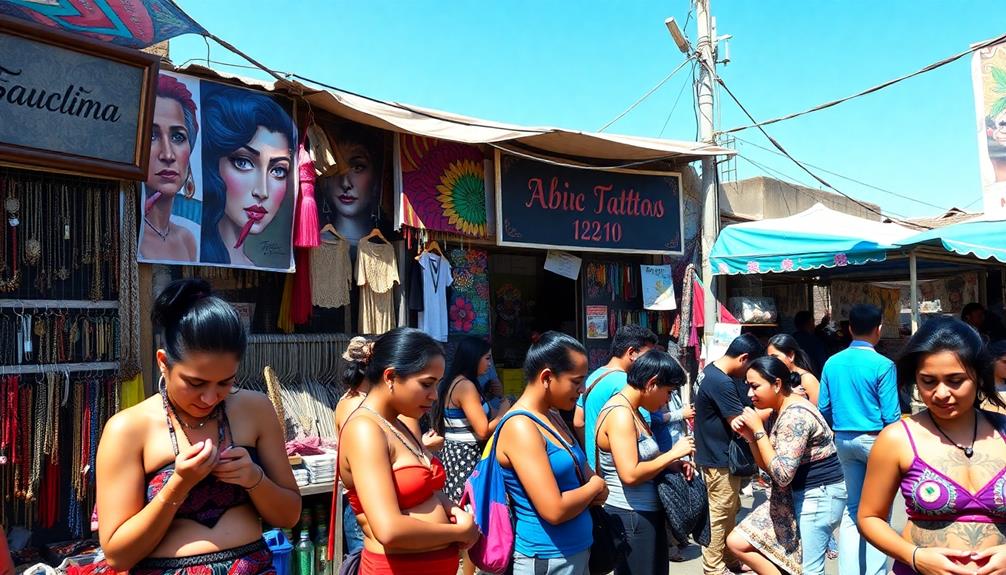
If you're exploring piercing tourism, you'll find that each destination offers unique techniques and styles tied to cultural significance.
From Thailand's intricate facial piercings to Japan's fusion of Irezumi and body piercings, the experiences are rich and varied.
Cities like Los Angeles and New York also present cutting-edge options, making them popular spots for those looking to enhance their body art.
Cultural Significance of Piercings
Piercings hold deep cultural significance across the globe, with various destinations offering unique experiences that reflect their traditions.
In Thailand, for instance, the Karen people, known as the "long-neck tribe," engage in traditional ear stretching practices. Here, piercings symbolize beauty and cultural identity, drawing visitors enthusiastic to understand this unique body modification.
In India, nose piercing is a longstanding tradition, particularly within Hindu culture. The right nostril is often pierced during marriage rituals, making cities like Varanasi popular for those seeking this meaningful modification.
Traveling to New Zealand, you'll discover the Māori practice of ta moko, where intricate facial tattoos express personal and tribal identity, attracting tourists interested in authentic cultural experiences.
In Japan, piercing has evolved into a fashion statement, especially in Tokyo, where studios offer designs that range from traditional kanji characters to modern motifs, appealing to both locals and tourists.
Lastly, in the United States, cities like Los Angeles and New York are thriving hubs for avant-garde piercing styles, showcasing innovative body modification practices that attract those looking for the cutting edge in personal expression.
Unique Techniques and Styles
Around the world, unique techniques and styles in body modification attract tourists keen for authentic experiences. Each destination offers something distinct, whether it's traditional methods or modern innovations.
| Destination | Unique Technique | Cultural Significance |
|---|---|---|
| Thailand | Bamboo needles for ear and body piercings | Cultural experience with modern flair |
| India | Nose piercing with varied styles | Deep cultural significance |
| New Zealand | Moko (facial tattoos) | Indigenous practices |
| United States | Dermal anchors, surface piercings | Creative urban expressions |
| Japan | Irezumi (tattooing integrated with piercing) | Blend of cultural artistry |
In Thailand, you'll experience the age-old bamboo needle technique, while in India, nose piercings reflect rich regional traditions. New Zealand's moko tattoos tell stories of heritage, and urban centers in the U.S. showcase daring styles like dermal anchors. Japan captivates with its intricate Irezumi, merging tattooing and piercing for an unforgettable body modification journey. Each location not only enhances your piercing experience but also immerses you in the cultural narratives that shape these unique techniques.
Traditional Tattoo Practices Worldwide

Exploring traditional tattoo practices worldwide reveals a rich tapestry of cultural significance and artistry. Tattooing isn't just body art; it's deeply intertwined with identity, history, and social status.
For instance, ancient Egyptians adorned their skin with tattoos for spiritual and social reasons, showcasing their beliefs and roles within society. In Polynesia, moko tattoos signify lineage and commemorate significant life events, telling stories of heritage.
The Māori people of New Zealand exemplify this connection, as their intricate facial tattoos represent tribal heritage and social status, often distinguishing warriors from others. Meanwhile, tribal tattoos among the Picts in Scotland were designed to intimidate enemies and signify bravery.
Japanese Irezumi boasts elaborate designs that reflect cultural and artistic expression, enhancing the wearer's identity.
In some African cultures, though, scarification is favored over tattooing, serving as a rite of passage and marking one's social status.
With recent cultural revival movements, traditional tattooing practices are experiencing a resurgence, emphasizing their importance in preserving cultural identity and heritage.
These diverse practices highlight the profound meanings behind tattoos, making them much more than mere ink on skin.
Unique Body Piercing Techniques
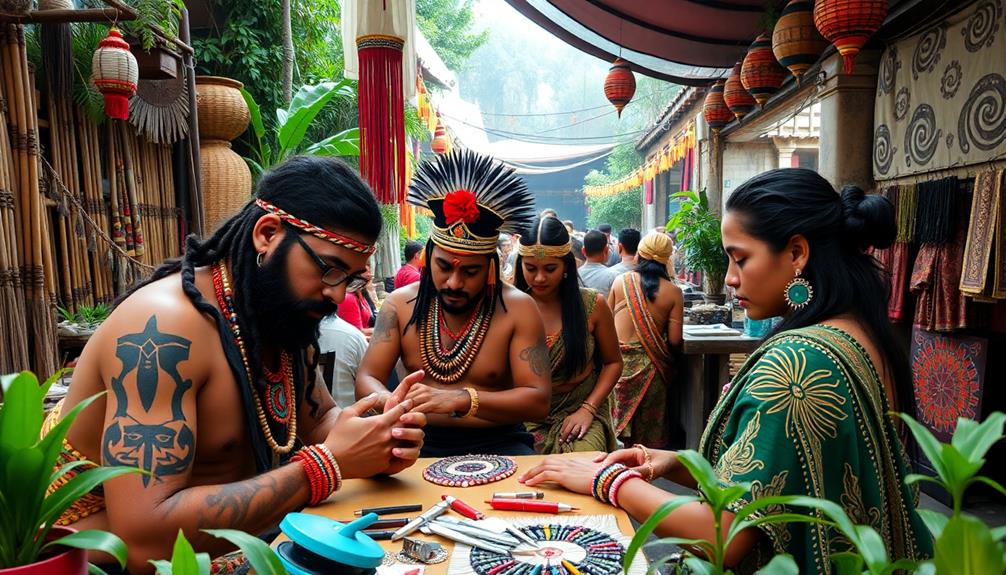
When it comes to unique body piercing techniques, cultures around the world showcase a fascinating array of methods and meanings. For instance, the Dogon tribe of Mali uses natural materials for septum jewelry, with lip rings holding deep religious significance.
In ancient Maya culture, piercing rituals involved stingray spines, where elite individuals publicly pierced their tongues, offering blood to the gods in acts of devotion.
Another intriguing technique is corset piercing, where a series of piercings are made along the spine, laced with ribbons for both aesthetic appeal and an erotic aspect when tightened.
Nose piercing, too, has a rich history, with evidence showing it's been practiced in the Middle East since around 4,000 B.C., carrying varied cultural significance across regions.
Modern advancements have also introduced innovative methods like subdermal implants, which allow you to insert anchors or decorative objects beneath the skin, creating striking body art.
These unique body piercing techniques not only reflect personal expression but also connect individuals to their cultural roots, making each piercing a story worth telling.
Modern Trends in Body Modifications
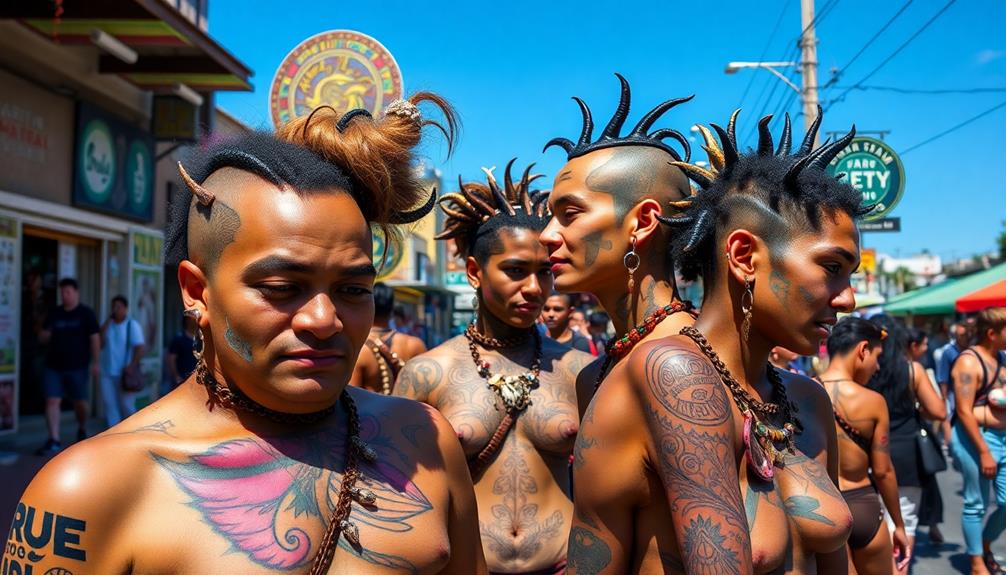
Modern body modifications have gained significant traction, as people increasingly embrace diverse practices that reflect their individuality and self-expression. The popularity of body piercing has surged, with common areas like lips, eyebrows, and nostrils becoming mainstream. This cultural shift normalizes various forms of body modification, encouraging a broader demographic to explore these practices.
Among the more extreme forms are tongue splitting and scarification, which some consider spiritual journeys. The Church of Body Modification (COBM) emphasizes personal authority over one's body, promoting these modifications as part of a deeper identity exploration.
Technological advancements like the pneumatic tattoo machine have revolutionized tattooing, making the process more efficient and accessible, further fueling interest in tattooing and piercing.
As societal norms shift, the lines between health and harm blur, leading more individuals to participate in these practices previously deemed taboo. This growing acceptance is reshaping how we view body modifications, highlighting the importance of self-expression while also reflecting personal beliefs and identities.
In this ever-evolving landscape, modern body modifications aren't just trends; they're powerful statements about who you are.
Health and Safety Considerations
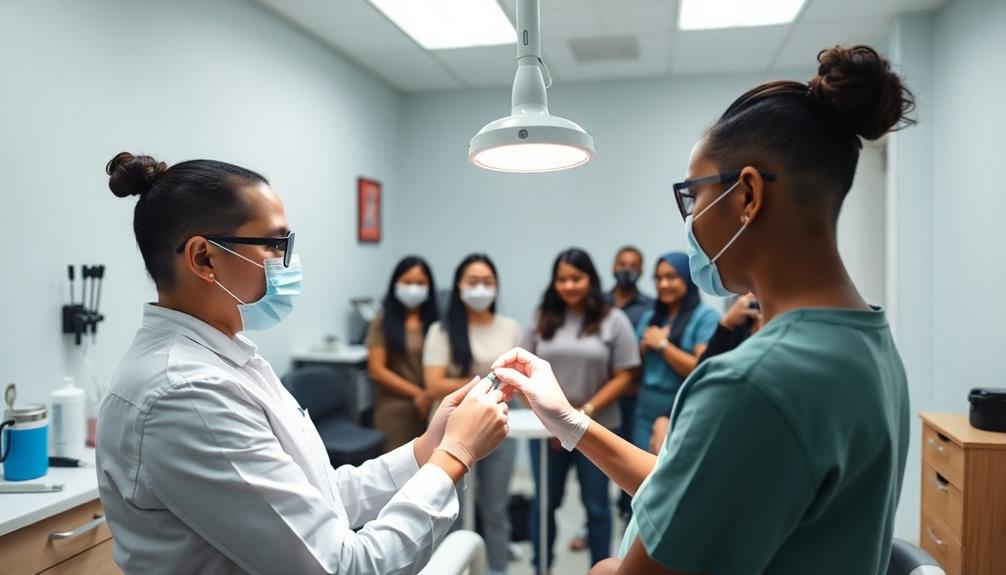
As body modification tourism grows in popularity, it's imperative to contemplate the health and safety implications associated with these practices.
When you consider getting a piercing abroad, be aware that unregulated or unsanitary environments can expose you to serious health risks, including infections and complications. Different countries have varying regulations regarding piercing, so it's important to research local standards before making a decision.
Prioritizing aftercare is crucial for preventing infections. Make sure you know the specific aftercare requirements for the type of piercing you receive, as these guidelines can vary markedly from one destination to another.
Always choose establishments that use sterile equipment and prioritize hygiene; this greatly enhances your safety.
Lastly, keep in mind the potential for allergic reactions to jewelry materials. Some metals, like nickel or non-biocompatible materials, can cause adverse reactions.
Personal Stories of Transformation
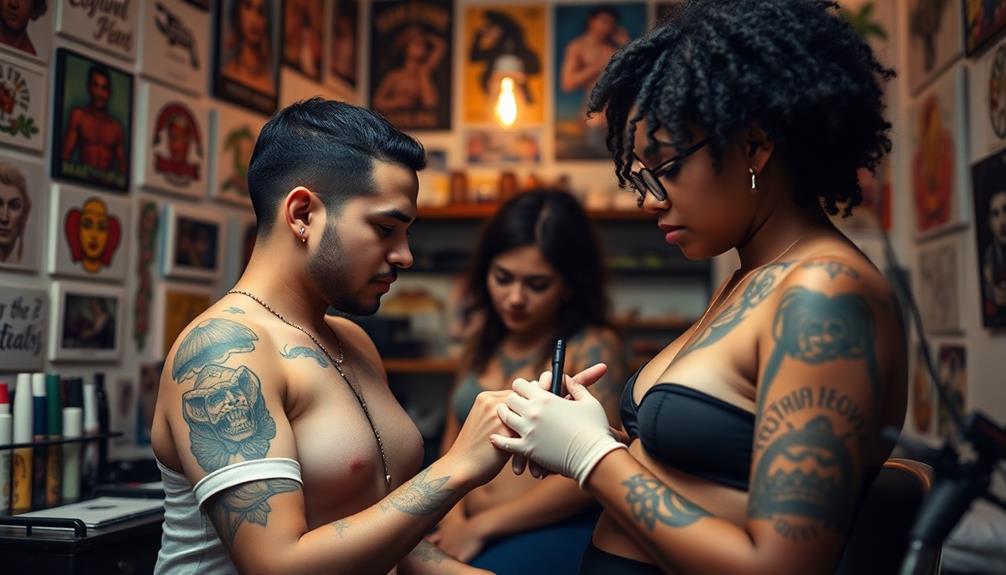
Starting on a journey for body modification can lead to profound personal transformations that resonate far beyond the physical changes. As you explore various forms of body art, you might discover deeper connections to culture, heritage, and even yourself.
Consider the stories of fellow travelers who ventured to unique destinations. In Bali, some have felt empowered through traditional tooth filing, connecting with ancient customs. Others have sought the spiritual significance of Irezumi in Japan, where intricate tattoo designs tell their life's narrative.
Here's a glimpse into the personal transformations experienced by others:
| Destination | Modification Type | Personal Impact |
|---|---|---|
| Bali | Traditional tooth filing | Connection to cultural roots |
| Thailand | Neck elongation rituals | Enhanced sense of beauty |
| Maya | Historical tattooing | Reconnection with ancestral identity |
| Nepal | Nostril and septum piercings | Spiritual awakening |
These personal stories illustrate how being pierced or tattooed can serve as a catalyst for growth, helping you embrace your identity and find beauty in cultural practices. Each modification can symbolize a journey of self-discovery, making it more than just skin deep.
Future of Body Modification Tourism
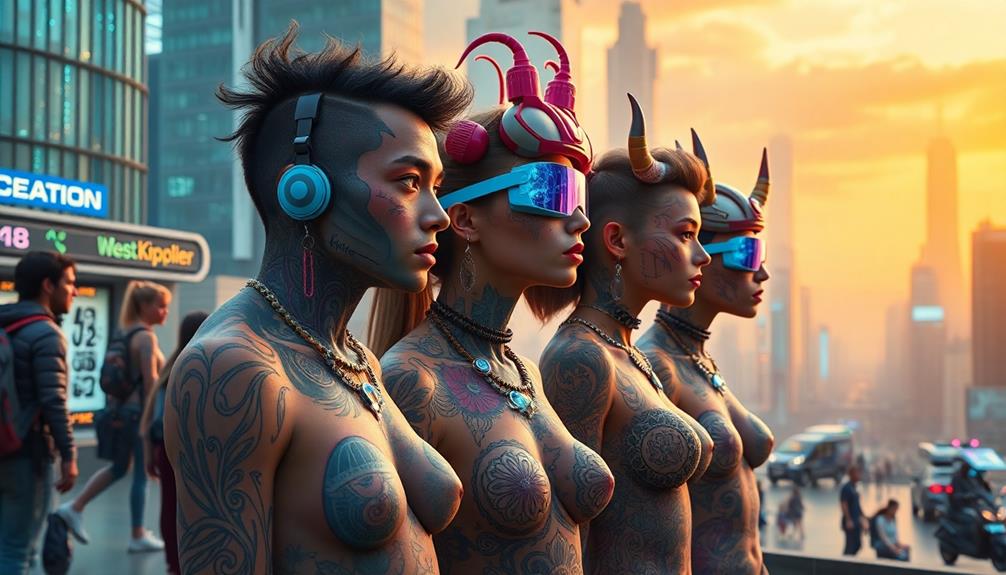
As body modification tourism grows, you'll likely see new global destinations emerging that offer unique cultural experiences and authentic practices.
However, with this expansion, you'll need to take into account the health and safety regulations in each location to guarantee a safe experience.
Balancing cultural significance with modern standards will shape the future of your body modification journey.
Emerging Global Destinations
Body modification tourism is rapidly evolving, with several emerging global destinations capturing the attention of adventurous travelers.
Bali, for instance, offers traditional practices like tooth filing and intricate tattooing, enticing you with a blend of cultural authenticity and unique experiences. The precision involved in these practices mirrors the careful calibration seen in high-quality projectors, which can greatly enhance visual experiences color accuracy impacts overall image quality.
If you're drawn to spirituality, Thailand's renowned Sak Yant tattoos might be just what you seek. These sacred designs are believed to provide protection and good fortune, making them a popular choice for those interested in the deeper significance of body art.
In New Zealand, the Māori practice of tā moko has gained international acclaim, offering you the chance to connect with indigenous culture through authentic tattoo experiences.
Australia's annual "Body Modification Expo" is another hotspot, where enthusiasts and practitioners gather to showcase the latest trends in body modification, making it a must-visit for anyone passionate about this art form.
Social media has also played a key role in promoting niche tourism, particularly in Japan, where unique piercing styles and tattoo artistry captivate travelers.
As body modification tourism continues to grow, these emerging destinations will certainly provide unforgettable experiences for those willing to explore.
Cultural Significance and Authenticity
In the domain of body modification tourism, understanding cultural significance and authenticity is fundamental for a meaningful experience.
As you explore unique piercing practices around the globe, consider how each modification carries deep-rooted meanings within the cultures that birthed them. For instance, septum piercings in Nepal and India symbolize various aspects of identity and tradition, while tribal tattoos in Polynesia represent heritage and status.
When traveling to destinations like Bali, where tooth filing signifies social status and personal achievements, it's essential to approach these practices with respect.
Authenticity matters; travelers often seek genuine experiences rather than commodified versions of cultural body modification. As globalization spreads these practices, awareness of cultural appropriation becomes critical.
Participate in sacred rituals only when you fully grasp their significance, ensuring you honor local customs rather than exploit them.
Health and Safety Concerns
Maneuvering the world of body modification tourism comes with significant health and safety concerns that travelers need to contemplate. When seeking unique modifications abroad, you might encounter unregulated practitioners who may not adhere to proper health standards.
To guarantee your safety, consider these important factors:
- Research: Investigate the reputation of the clinic and its practitioners before booking an appointment. It's also advisable to look into potential side effects associated with certain body modifications.
- Licensing: Verify that the practitioners are certified and meet local health regulations.
- Sterilization Practices: Confirm that the clinic follows proper sterilization practices to minimize the risk of infections.
- Aftercare Guidance: Guarantee you receive adequate aftercare instructions to promote healing and prevent complications.
With the rise of body modification tourism, many countries are tightening licensing requirements to enhance safety. However, travelers must remain vigilant.
Prioritize clinics that demonstrate a commitment to hygiene and safety protocols. By taking these precautions, you can reduce your health and safety concerns while enjoying your body modification experience to the fullest.
Frequently Asked Questions
What Is Piercing Body Modification?
Piercing body modification involves creating intentional openings in your body for decorative purposes. Common places include ears and noses, serving cultural, spiritual, or aesthetic functions while reflecting personal identity and evolving beauty standards in society.
What Cultures Use Body Modification?
You'll discover that various cultures embrace body modification as a profound expression of identity. From the intricate tattoos of Polynesians to the meaningful piercings in Nepal, each practice tells a unique story of heritage and significance.
What Is the Body Modification in Thailand?
In Thailand, you'll discover vibrant body modification practices, like sak yant tattoos and ear stretching. These traditions reflect deep spirituality, often celebrated during cultural festivals, blending ancient techniques with modern styles for a unique experience.
What Are Two Examples of Body Modifications Being Done for Practical Purposes?
You see beauty in adornment, yet practicality lies beneath. Consider ear piercings, enhancing jewelry wear, and nose piercings, believed to ease menstrual pain. Both serve as symbols of identity and functionality across cultures.
Conclusion
As you journey through the vibrant tapestry of body modification, you'll discover more than just piercings; you'll uncover stories woven into cultures and traditions. Each needle's touch transforms skin into art, celebrating individuality and heritage. The allure of unique techniques and modern trends invites you to embrace your own transformation. In this world of ink and metal, you find not just destinations, but a deeper connection to the body and soul—an adventure waiting to be experienced.

